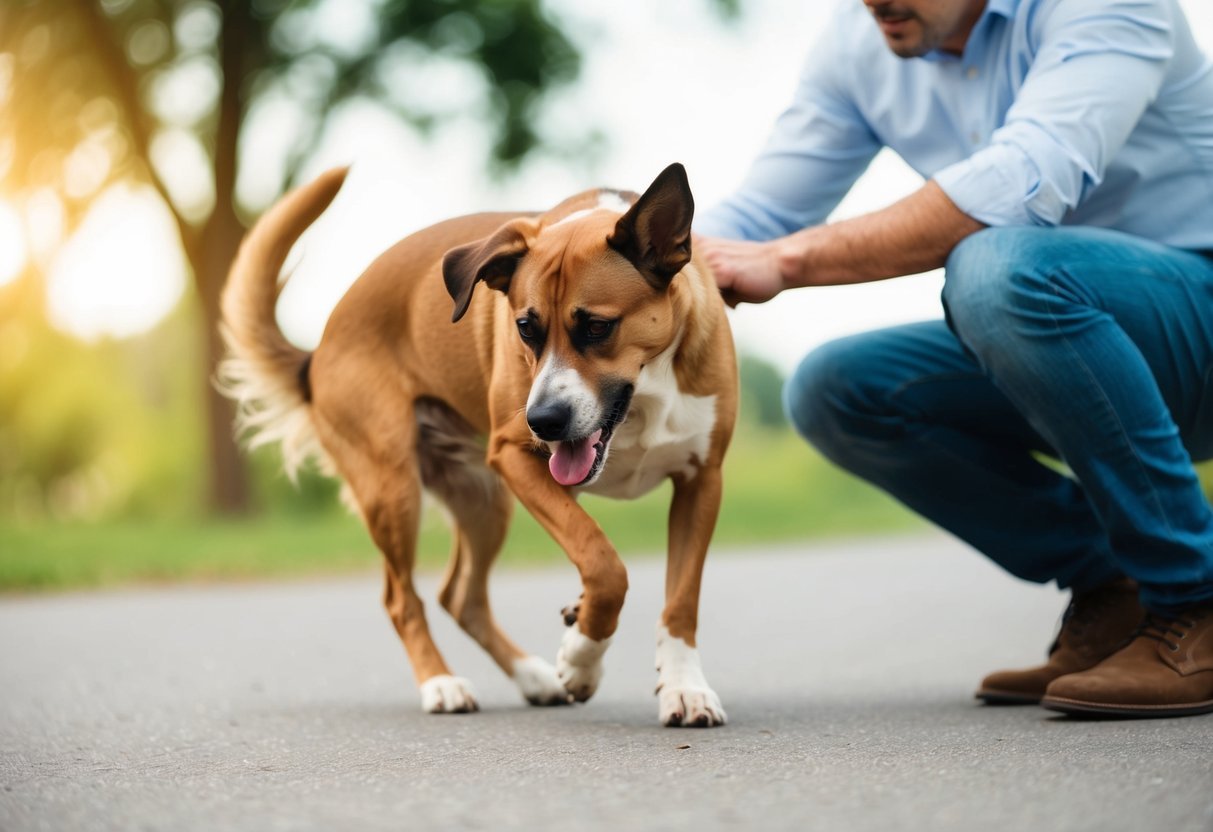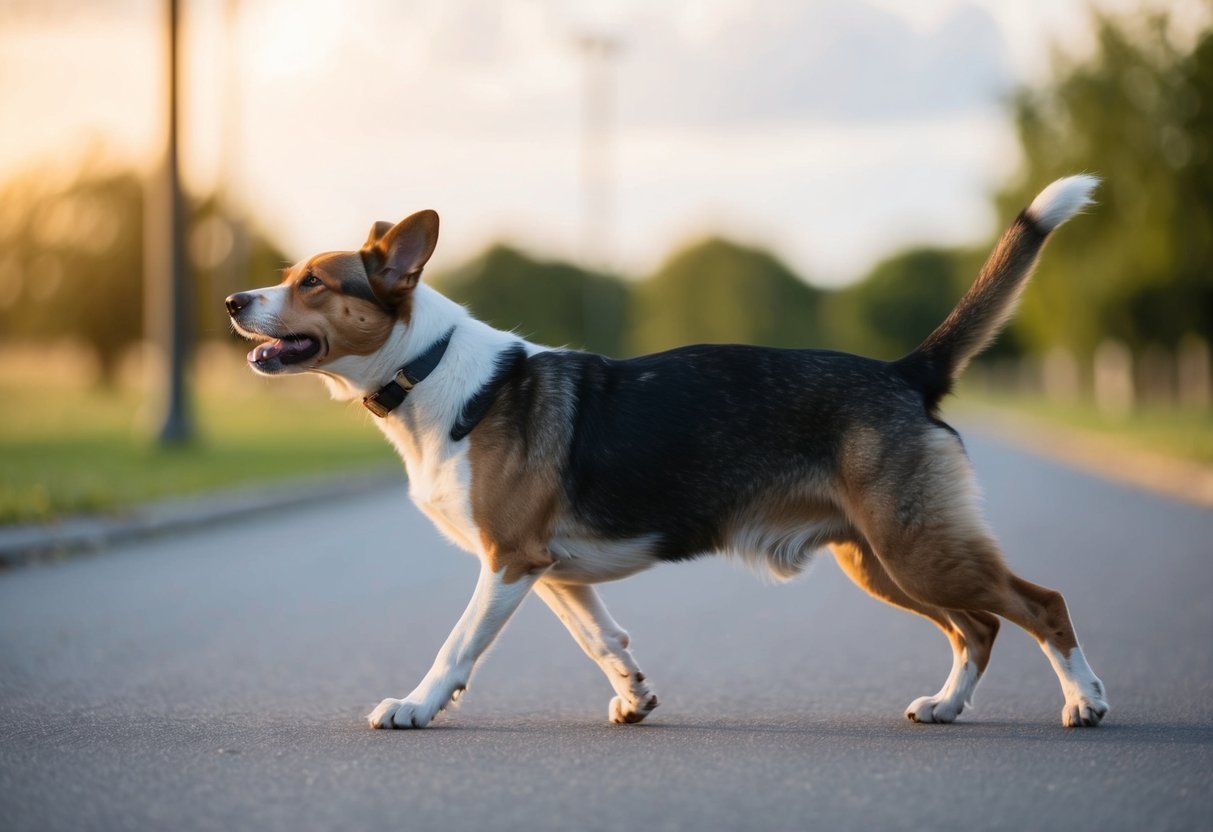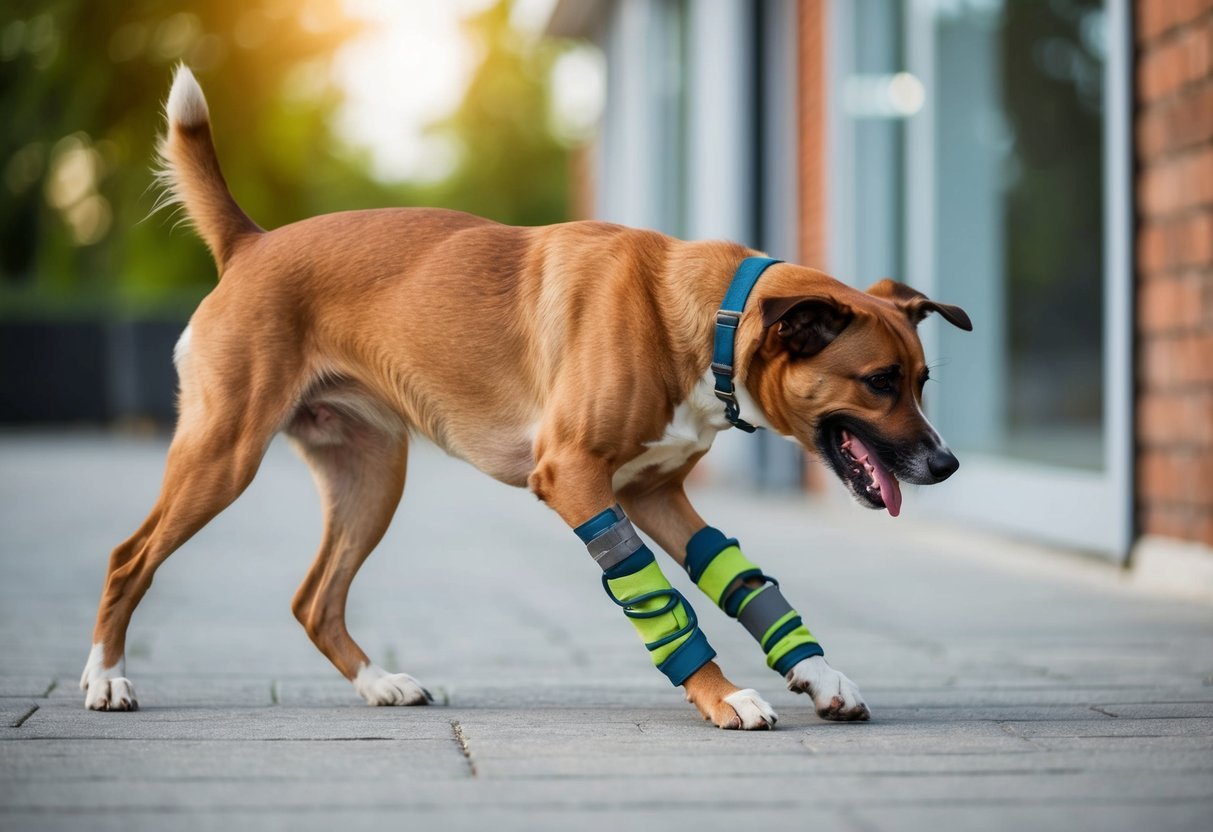As a dog owner, you want to ensure your furry friend is healthy and happy.
Sometimes, you might notice unusual walking patterns that can be concerning. Recognizing these bizarre walking problems early can help you get the necessary care for your dog.
Every dog owner should know the signs that indicate something might be wrong.
While some issues may seem minor, others could signal serious health problems that need immediate attention.
Being aware of these walking problems allows you to act quickly to protect your pet’s well-being.
Sudden Limping
If your dog starts limping suddenly, it can be concerning.
This might happen due to an injury or trauma.
If you notice this change, it’s important to take it seriously.
Common causes include ligament damage or even a simple sprain.
Your dog may be in pain, and limping is a way for them to cope.
Make sure you observe how they are moving.
You can check the limping leg gently for visible signs of injury like swelling or cuts.
This can help you understand what might be wrong.
If you notice anything unusual, it’s best to consult a vet right away.
Even if the limping seems minor, it might indicate a more serious issue.
Conditions like arthritis can also cause sudden limping.
Dogs, especially older ones, are prone to issues with their joints.
It’s essential to encourage your dog to rest.
Avoid walks or playtime until a professional examines them.
Keeping your dog calm can help prevent further injury.
Unusual Gait Patterns
When your dog walks, you expect them to move in a certain way.
If you notice they are limping, staggering, or favoring one side, it may indicate an unusual gait.
Different dogs have different gaits depending on their size and breed.
For example, small breeds like Chihuahuas might develop strange walking patterns that need attention.
If your dog suddenly starts walking differently, it could be a sign of pain or an injury.
You should pay attention to how your dog moves.
They might seem fine while walking but show problems when trotting or running.
A change in movements could mean something is off.
Sometimes, dogs may struggle to get up or change directions smoothly.
This can be due to joint issues or other health problems.
If you notice any of these signs, it’s best to consult a vet.
Early detection of unusual gait patterns is important for your dog’s health.
Addressing these issues promptly can lead to better outcomes and keep your furry friend happy and active.
Dragging Rear Legs

Seeing your dog drag their back legs can be worrying.
It usually means they’re having trouble with their movement.
This can happen for many reasons.
One common cause is nerve damage.
If you notice weakness or difficulty in standing, it might be a sign of this issue.
Muscle wasting can also occur if the problem isn’t addressed.
Another reason for dragging is joint problems.
Arthritis can make it hard for older dogs to walk normally.
You might see them struggling to get up or move around.
If your dog’s back legs suddenly give out, it could indicate a serious issue.
Conditions like intervertebral disc disease (IVDD) can lead to sudden weakness.
It’s important to get your dog checked by a vet right away.
Take note of any changes.
If your dog is dragging their back legs, contact your vet.
Early diagnosis can help improve their quality of life and mobility.
4) Stiffness After Rest

If your dog shows stiffness after resting, it could be a sign of a few issues.
Many dogs, especially older ones, may find it hard to get moving right after a nap.
This stiffness can stem from conditions like arthritis.
You might notice your dog takes longer to get up or walks slowly at first.
This can be frustrating for both you and your pet.
If it’s just occasional, it might not be worrisome.
On the other hand, if your dog frequently struggles to stand or move, it’s best to consult a vet.
Stiffness can indicate joint problems and might require treatment.
Regular exercise and a proper diet can help keep your dog’s joints healthy.
Pay attention to how often your dog has trouble walking after rest.
Keeping track of this can help your vet diagnose the issue.
Don’t ignore these signs, as early intervention can improve your dog’s quality of life.
Frequent Tripping

If your dog is frequently tripping while walking, it’s important to pay attention.
This issue can be a sign of several underlying problems.
Sometimes, tripping happens because of a physical condition.
It could be due to pain or injuries in their legs or paws.
If you notice changes in their walking, look for signs like limping or reluctance to move.
Neurological issues may also cause your dog to stumble.
This happens when the brain or nervous system does not send the right signals to their muscles.
If your dog seems unsteady or wobbly, it’s best to consult a vet.
Older dogs might trip more often due to weakened muscles or joint problems.
Arthritis is common in aging pets and can affect their balance and movement.
Pay attention to how your dog behaves in different terrains.
If they have trouble on uneven surfaces, that might indicate a balance issue.
Keeping an eye on their behavior can help you spot any problems quickly.
If your dog trips regularly, don’t delay in seeking professional advice.
A vet can help identify the cause and recommend the right treatment.
Your pup’s safety and well-being should always come first.
Understanding Canine Mobility Issues

Canine mobility issues can arise from various causes and recognizing early symptoms is crucial for your dog’s well-being.
These problems can affect how your dog walks, stands, and plays, impacting their quality of life.
Causes of Walking Problems in Dogs
There are many reasons your dog might struggle to walk.
Some common causes include:
- Arthritis: This condition leads to painful inflammation in joints, making movement difficult.
- Injury: Sprains, fractures, or muscle tears can cause immediate walking issues.
- Neurological Disorders: Conditions affecting the brain or nervous system can alter your dog’s coordination.
- Hip Dysplasia: A genetic disorder where the hip joint doesn’t fit properly, which can cause pain and limping.
- Obesity: Extra weight can strain your dog’s joints and lead to mobility problems.
Understanding the specific cause of your dog’s mobility issues is important for effective treatment.
Recognizing Early Symptoms
Being aware of early signs can help you act quickly.
Look for:
- Changes in Gait: Uneven steps or limping can indicate discomfort.
- Reluctance to Move: If your dog seems hesitant to walk or play, it might be a sign of pain.
- Vocalizations: Uncharacteristic whining or growling when walking can suggest they’ve hurt themselves.
- Excessive Licking: If your dog licks a specific joint, it may be a signal of pain or irritation.
- Posture Changes: A hunched back or unsteady stance can also indicate issues.
Acting fast on these symptoms can make a big difference in your dog’s mobility and overall health.
Seeking Veterinary Guidance

When your dog shows unusual walking problems, it’s crucial to know when to seek help.
Taking action quickly can make a difference in your pet’s health and comfort.
Let’s explore the signs that indicate a trip to the vet and how to prepare for your visit.
When to Consult a Vet
You should consult a vet if your dog exhibits any of these signs:
- Sudden Weakness: If your dog suddenly struggles to stand or walk, get help right away. This could indicate serious issues like injury or neurological problems.
- Extreme Pain: Whining, yelping, or flinching when touched are signs of pain.
- Loss of Coordination: If your dog seems unsteady or wobbly, this might suggest underlying health problems.
- Behavior Changes: Unexplained changes in behavior, like increased aggression or confusion, should not be ignored.
Each symptom could mean a different issue, and timely veterinary advice is essential.
Preparing for the Vet Visit
Preparation can make your vet visit smoother.
Here’s how to get ready:
-
Gather Information: Note any changes in your dog’s behavior, appetite, or energy levels.
-
Record Symptoms: Write down when the walking problems started and whether they got worse.
-
List Medications: Bring a list of any medications or supplements your dog is taking.
-
Ask Questions: Prepare a list of questions you want to ask your vet about your dog’s condition.
-
Bring Comfort Items: If your dog has a favorite blanket or toy, bring it along to help them feel at ease.
Being prepared helps your vet understand the problem and assists in making the right diagnosis.
Frequently Asked Questions

If you notice changes in your dog’s walking, it’s important to understand the possible reasons.
Below are some common queries that can help clarify what’s happening with your furry friend.
What causes a sudden change in my dog’s walking pattern?
A sudden change in your dog’s walking can stem from various issues.
It may be due to an injury, arthritis, or even neurological problems.
Always observe for other symptoms like pain or swelling and consult your vet for an accurate diagnosis.
Could hip dysplasia be affecting my dog’s way of walking?
Yes, hip dysplasia can impact your dog’s walking pattern significantly.
This condition can cause pain and instability in the hips, leading to a wobbly gait or limping.
If you suspect this, a check-up with your vet is essential for proper treatment options.
What are the signs of hind leg ataxia in dogs?
Hind leg ataxia often shows up as a lack of coordination in the back legs.
You may notice your dog staggering, crossing their legs while walking, or having difficulty standing.
It’s critical to see a vet if you observe these signs to determine the underlying cause.
Why is my dog having a hard time standing and seems unstable on their feet?
If your dog struggles to stand or seems unsteady, it could signal several issues like arthritis, muscle weakness, or neurological conditions.
Pay attention to whether these problems develop slowly or come on suddenly, as that can guide your vet in diagnosing your pet.
Can you explain proprioceptive ataxia and its symptoms in dogs?
Proprioceptive ataxia refers to a lack of awareness of body position.
Symptoms include dragging feet, swaying, or difficulty turning.
Dogs may seem to “misplace” their feet, which can lead to frequent tripping over their own legs.
A vet can help determine if this is the issue.
Why does my young dog waddle instead of walking normally?
A waddling gait in a young dog can often be due to muscle or joint issues such as hip dysplasia or loose ligaments.
It can also indicate developmental problems that need attention.
If this persists, you should get your vet’s advice to rule out serious conditions.

